Physical Address
304 North Cardinal St.
Dorchester Center, MA 02124
Physical Address
304 North Cardinal St.
Dorchester Center, MA 02124
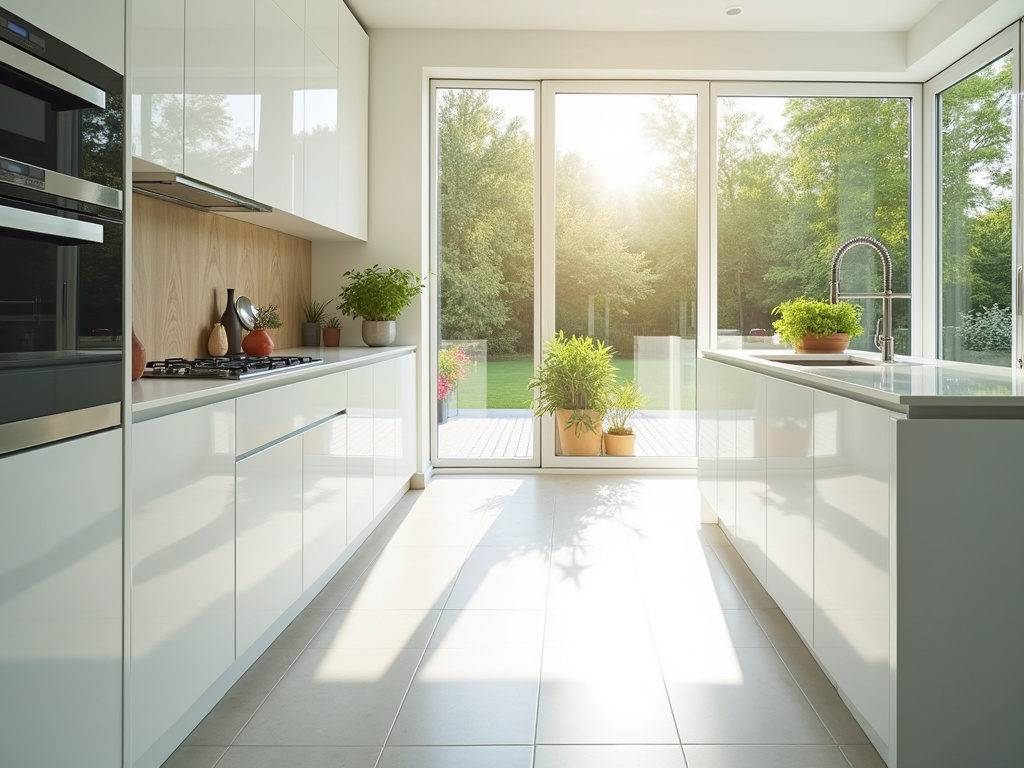
Is there anything quite as universally appealing as a bright, airy, and impeccably stylish White Kitchen? For decades, the white kitchen has reigned supreme in home design, and for good reason. More than just a trend, it’s a design philosophy that embodies cleanliness, spaciousness, and a timeless elegance that can adapt to any style. Whether you’re dreaming of a complete overhaul or just looking for a few tweaks to refresh your space, get ready to be inspired. Let’s explore these dreamy white kitchen design ideas that will ignite your imagination and help you create the kitchen of your dreams.
Think of a white kitchen as the little black dress of interior design – it’s timeless, versatile, and always in style. But what makes white kitchens truly transcend trends? The answer lies in their remarkable adaptability and the sense of serenity they bring to our homes. Like a blank canvas waiting for an artist’s touch, white kitchens provide the perfect foundation for expressing your personal style through accents, textures, and carefully chosen details.
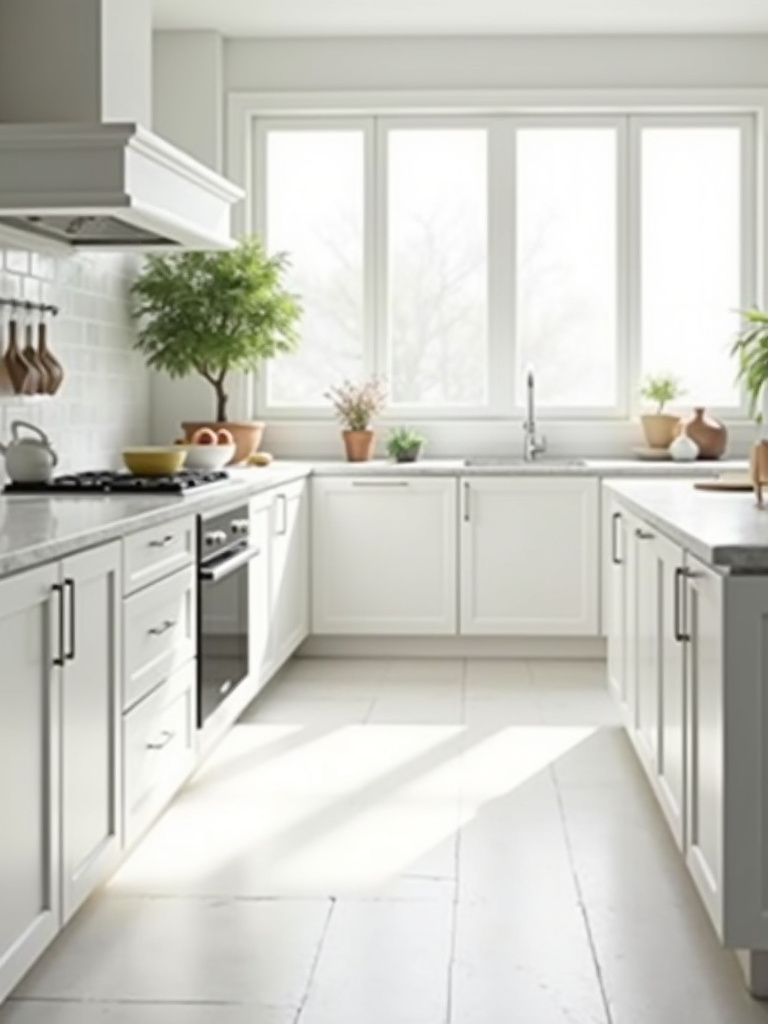
The enduring appeal of white kitchen design isn’t a recent phenomenon. Dating back to the early 20th century, white kitchens emerged as a symbol of cleanliness and modernity. This historical connection to both hygiene and sophistication has only strengthened over time, making white kitchens a perennial favorite among homeowners and designers alike. When planning your own timeless white space, consider classic elements like Shaker-style cabinets or clean-lined hardware – choices that will look as fresh a decade from now as they do today.
To maintain that timeless appeal while avoiding sterility, consider incorporating natural materials and varying textures. A marble countertop with delicate veining or a rich wooden island can add warmth while maintaining the classic white kitchen aesthetic that has proven its staying power.
Natural light is the secret ingredient that transforms a good white kitchen into a great one. The way sunlight plays across white surfaces creates an almost magical effect, making your space feel larger, more inviting, and infinitely more dynamic. Strategic placement of windows and thoughtful design choices can maximize this effect, turning your kitchen into a light-filled sanctuary that changes character throughout the day.
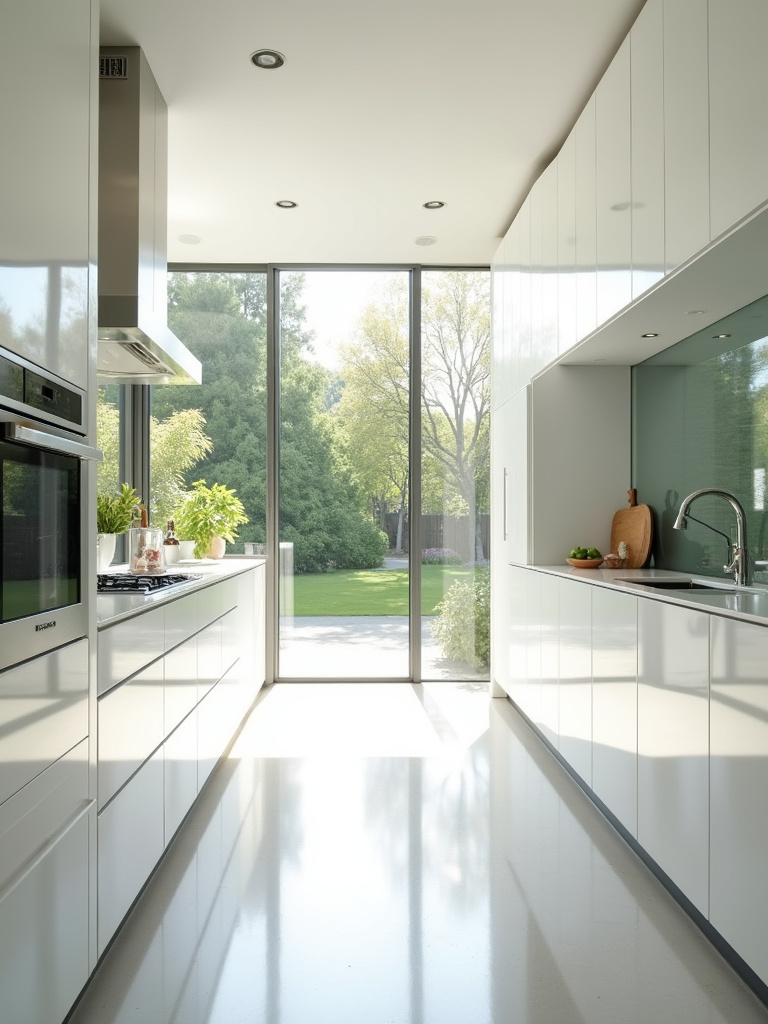
But what if your kitchen isn’t blessed with walls of windows? That’s where clever design tricks come into play. Reflective surfaces become your allies in the quest for brightness. High-gloss cabinet finishes, mirrors strategically placed to bounce light, and metallic accents can all help amplify whatever natural light you have. Even something as simple as positioning your main workspace near a window can make a dramatic difference in how you experience your kitchen throughout the day.
Consider this fascinating fact: white surfaces reflect up to 80% of light, making them incredibly efficient at maximizing brightness. This natural amplification effect means that every ray of sunlight entering your kitchen works harder, creating that coveted bright and airy feeling that makes white kitchens so appealing.
Don’t let limited square footage dampen your white kitchen design dreams. In fact, a smaller space can be the perfect canvas for creating a stunning white kitchen that feels surprisingly spacious. The key lies in understanding how to make every inch work harder while maintaining a clean, uncluttered aesthetic that makes the room feel larger than its actual dimensions.
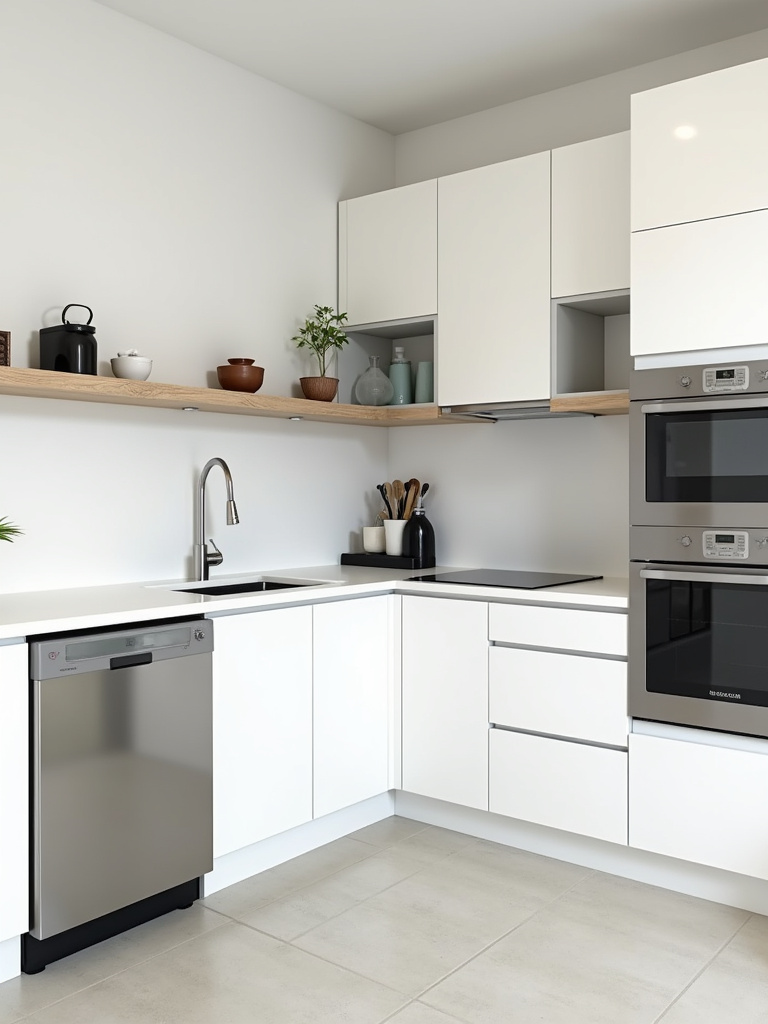
Think vertically. Extending cabinets to the ceiling not only maximizes storage but draws the eye upward, creating an illusion of height that makes the entire space feel more expansive. Clever storage solutions like pull-out pantry shelves and deep drawers with organizers keep necessities close at hand while maintaining that coveted clutter-free look. Even small details matter – choosing light-colored or mirrored backsplashes can help reflect light and visually expand your space.
In compact kitchens, consider integrating appliances behind cabinet panels to maintain visual continuity, and opt for sleek, space-saving models that offer full functionality without dominating the room. This approach to white kitchen design in small spaces proves that you don’t need vast square footage to create a kitchen that’s both beautiful and highly functional.
While the crisp cleanliness of white is undeniably appealing, the key to creating a truly inviting white kitchen lies in knowing how to warm up the space. Think of your white kitchen as a symphony – while white may be the dominant note, it’s the harmonious blend of textures and materials that creates a rich, welcoming atmosphere that draws people in and makes them want to linger.

Natural materials are your best friends in this endeavor. A butcher block island top brings organic warmth and practical functionality. Open shelving in warm wood tones adds character while providing display space for colorful cookware or treasured collections. Even something as simple as a textured backsplash – perhaps handmade ceramic tiles with subtle variations in shade and surface – can add depth and interest while maintaining the overall white kitchen aesthetic.
Layer in textiles and tactile elements to create a cozy vibe. A vintage runner with muted patterns, woven baskets for storage, or linen window treatments can soften the harder surfaces typical in kitchen design. These thoughtful additions transform a stark white kitchen into a warm, inviting heart of the home.
In the realm of modern white kitchen design, less truly becomes more. Clean lines, minimal ornamentation, and thoughtful functionality combine to create spaces that feel both sophisticated and serene. The beauty of a modern white kitchen lies in its ability to make a bold statement through simplicity, letting carefully chosen elements shine without competition.
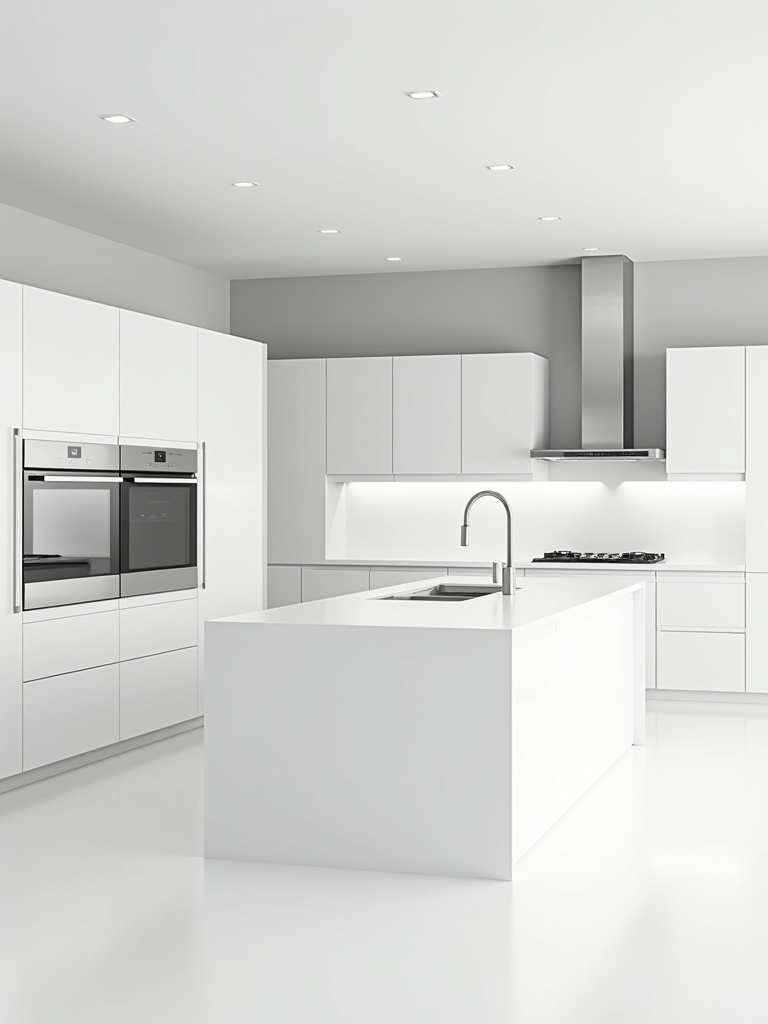
Handleless cabinets in high-gloss or matte finishes create smooth, uninterrupted surfaces that define modern kitchen aesthetics. These sleek facades can be punctuated by state-of-the-art appliances in stainless steel or integrated behind panels for an even more minimalist look. The key is maintaining visual clarity – every element should serve both a functional and aesthetic purpose, with nothing superfluous to distract from the clean design.
Consider incorporating geometric patterns or bold, architectural lighting fixtures to add interest while maintaining modernist principles. These elements can create dramatic focal points without compromising the streamlined aesthetic that makes modern white kitchens so appealing.
The farmhouse-style white kitchen proves that rustic charm and clean aesthetics can coexist beautifully. This beloved design approach combines the brightness and versatility of white with worn woods, vintage touches, and architectural details that speak to a simpler time. The result is a kitchen that feels both fresh and timelessly comfortable.

At the heart of farmhouse white kitchen design is the balance between refined and rustic elements. An apron-front sink becomes a natural focal point, while shiplap walls add architectural interest without overwhelming the space. Open shelving, perhaps crafted from reclaimed wood, provides both storage and display space for collections of enamelware or vintage kitchenware that add character and charm.
The beauty of a farmhouse white kitchen lies in its ability to feel both elegant and lived-in. It’s a space that welcomes muddy boots and fresh-picked flowers equally, where perfectly imperfect details add to rather than detract from its appeal.
The cabinets you choose set the tone for your entire white kitchen design, acting as the foundation upon which all other design elements build. Understanding the distinct personalities of different cabinet styles helps ensure your choice aligns perfectly with your vision for the space. From the clean lines of Shaker to the minimalist appeal of slab fronts, each style tells its own design story.
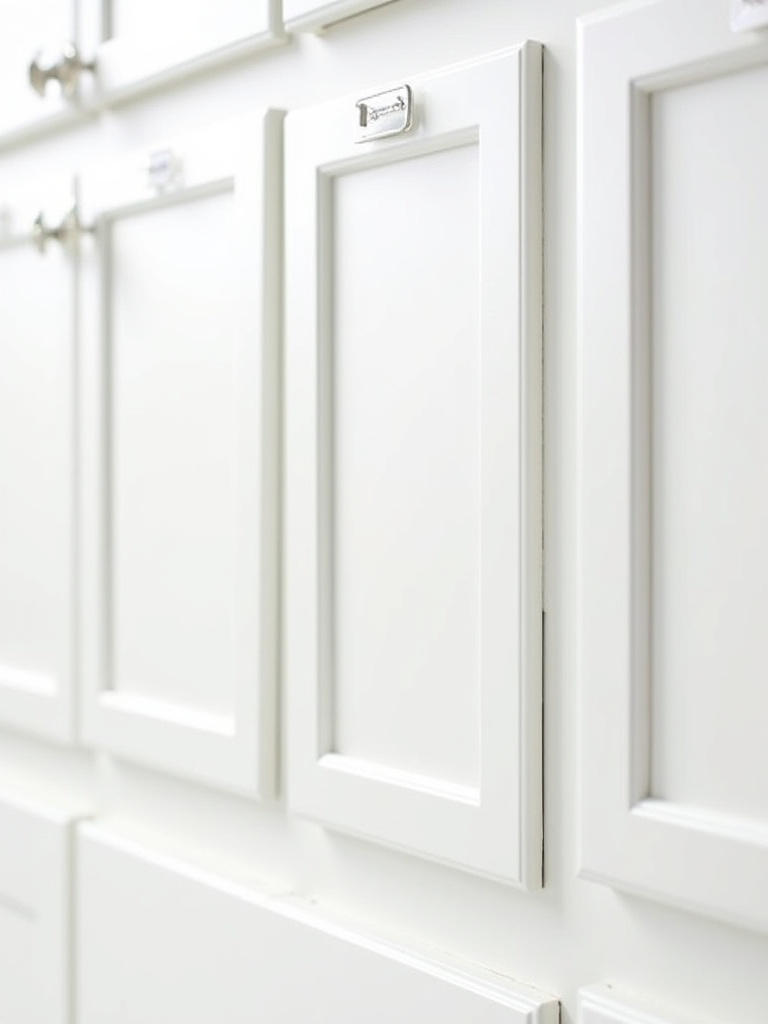
Consider the Shaker style, named for the religious sect known for their commitment to simplicity and quality craftsmanship. These cabinets, with their frame-and-panel construction, offer a versatile middle ground between traditional and contemporary design. Raised panel cabinets bring a more formal, traditional feel, while beadboard adds cottage charm. For modern enthusiasts, slab-front cabinets provide clean, uninterrupted lines that perfectly suit contemporary spaces.
Each cabinet style brings its own practical considerations along with its aesthetic appeal. Inset doors, while beautiful, tend to be more expensive and offer slightly less storage space. Slab fronts, while easiest to clean, can show fingerprints more readily in certain finishes. Understanding these nuances helps you make an informed choice that you’ll love for years to come.
Selecting the perfect countertop for your white kitchen is like choosing the right necklace for an outfit – it can either elevate the entire look or detract from its beauty. The good news is that white cabinets provide a versatile foundation that works beautifully with a wide range of countertop materials and colors, from dramatic dark granites to pristine white marbles and warm wood tones.

For those drawn to natural stone, white marble with its elegant veining has long been a classic choice in white kitchen design. However, modern alternatives like quartz offer similar beauty with greater durability and less maintenance. Granite, with its infinite variety of patterns and colors, can create striking contrast or subtle harmony, depending on the selection. For a warmer touch, butcher block countertops bring organic beauty and practical functionality to white kitchens.
The key to choosing the right countertop lies in understanding how it will function in your space. Consider not just the aesthetic appeal but also your lifestyle, maintenance preferences, and budget. A young family might prefer the durability of quartz, while an avid baker might opt for the natural cooling properties of marble for pastry work.
Think of your backsplash as the perfect accessory that can either whisper or make a bold statement in your white kitchen design. This vertical canvas offers an opportunity to inject personality and visual interest while maintaining the clean, bright aesthetic that makes white kitchens so appealing. Whether you opt for classic subway tiles or a dramatic geometric pattern, your backsplash can transform the entire feel of your space.
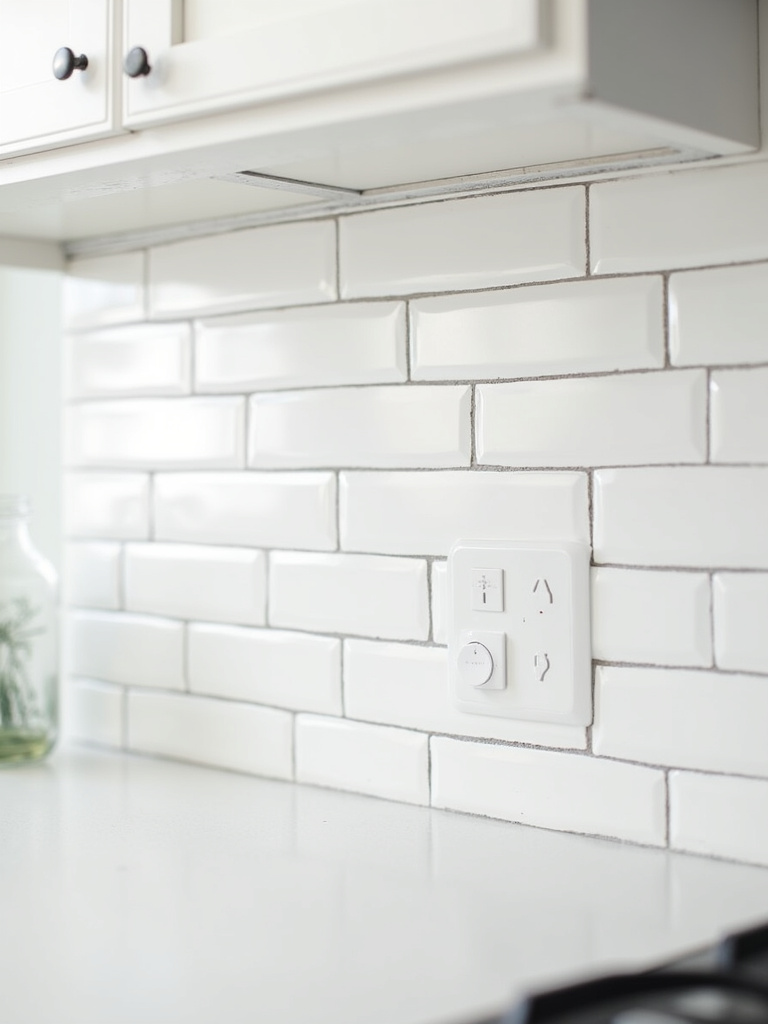
The beauty of designing a backsplash for a white kitchen lies in the endless possibilities. Classic white subway tiles, perhaps with contrasting grout, offer timeless appeal while adding subtle texture. Handmade ceramic tiles bring character through their slight imperfections and dimensional quality. For those seeking drama, consider a herringbone pattern or a mosaic that incorporates metallic elements to catch and reflect light.
Remember that your backsplash needs to work in harmony with your countertops and cabinets. Consider how different patterns and textures will interact with other elements in your kitchen, creating a cohesive design that feels intentional and well-thought-out.
Just as jewelry can make or break an outfit, hardware plays a crucial role in completing your white kitchen design. These small but mighty elements add personality, functionality, and that perfect finishing touch that can elevate your entire space. From sleek modern handles to vintage-inspired knobs, hardware choices help define your kitchen’s style story.
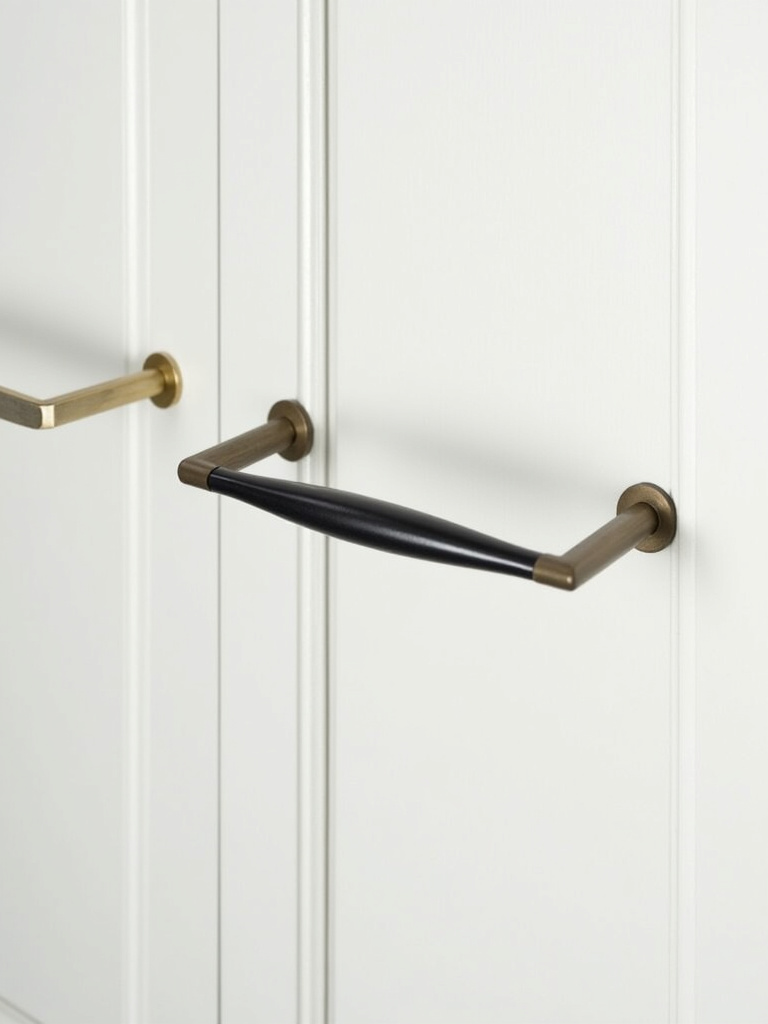
Today’s hardware options offer an exciting array of finishes and styles. Polished chrome and brushed nickel provide timeless appeal, while warm brass and gold add luxurious warmth. Matte black hardware creates dramatic contrast against white cabinets, perfect for modern or farmhouse-style kitchens. Even mixing metals has become an accepted and celebrated design choice, allowing for more personalized and interesting combinations.
The key to successful hardware selection lies in considering both aesthetics and functionality. Larger drawers might benefit from substantial pulls that make them easier to open, while upper cabinets might look better with simple knobs. Whatever you choose, ensure it complements other metallic elements in your kitchen, from light fixtures to faucets.
Lighting in a white kitchen is like orchestrating a symphony – each layer plays its own crucial role, but it’s the combination that creates true harmony. A well-planned lighting scheme not only enhances the beauty of your white kitchen design but also ensures it functions perfectly for everything from food prep to entertaining. The key lies in understanding and implementing different types of lighting to create a space that’s both beautiful and practical.
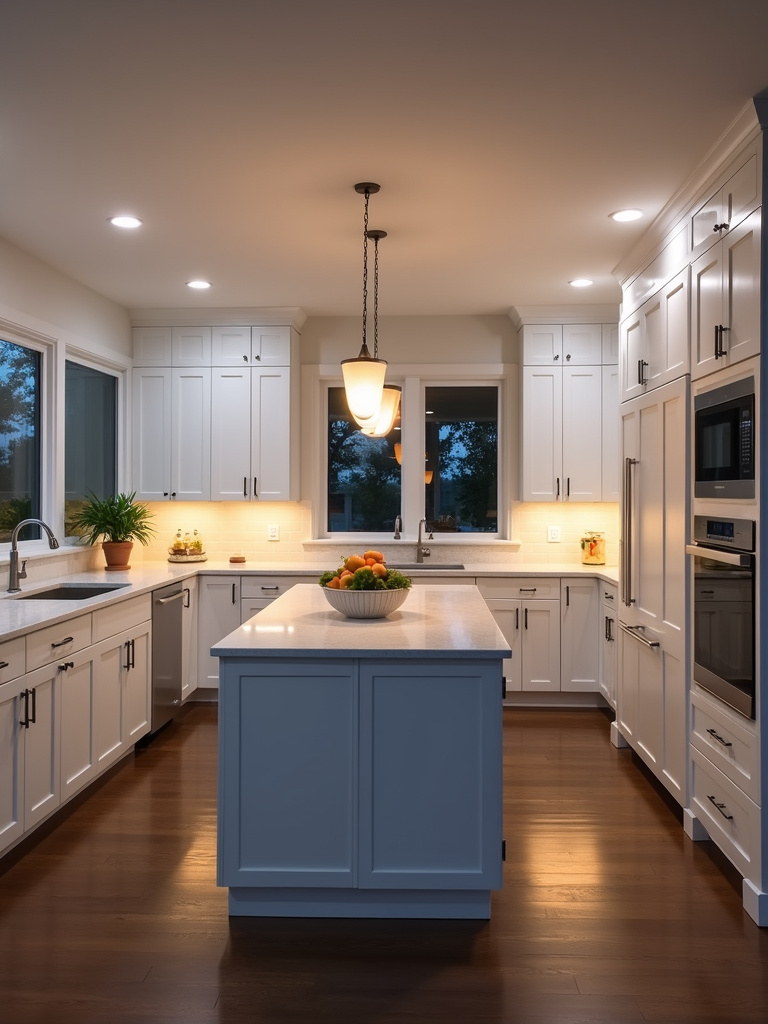
Start with ambient lighting to provide overall illumination. Recessed lights offer clean, modern functionality, while a statement chandelier or pendant lights can add personality and style. Task lighting, particularly under-cabinet lights, eliminates shadows on work surfaces and makes food preparation safer and more enjoyable. Finally, accent lighting can highlight architectural features or create atmosphere for evening entertaining.
Consider dimmers for all your lighting sources – they offer flexibility to adjust the mood and functionality of your kitchen throughout the day. Morning coffee might call for bright, energizing light, while evening gatherings might benefit from a softer, more intimate glow.
When it comes to flooring in a white kitchen, you’re faced with an intriguing design decision: do you continue the white theme underfoot or create contrast? Both approaches can work beautifully, but each creates a distinctly different feel in your space. The key is understanding how your flooring choice will impact the overall look and functionality of your white kitchen design.

Light-colored flooring can create a seamless, expansive feel that makes your kitchen appear larger and more open. Options like white porcelain tiles or light-washed hardwood offer durability while maintaining the bright, airy aesthetic. For those concerned about maintenance, today’s high-performance materials offer remarkable stain and wear resistance, making light floors more practical than ever.
However, don’t feel confined to white or light options. A darker floor can ground the space and create beautiful contrast, while still allowing your white cabinetry to shine. The key is choosing a material and color that complements your overall design vision while meeting your practical needs.
A white kitchen is like a gallery space – it provides the perfect backdrop for displaying pops of color that can transform the entire room’s personality. The beauty of a white kitchen design lies in its chameleon-like ability to embrace color without losing its timeless appeal. Whether you’re drawn to bold, vibrant hues or subtle, sophisticated tones, there’s a way to incorporate color that feels both fresh and intentional.
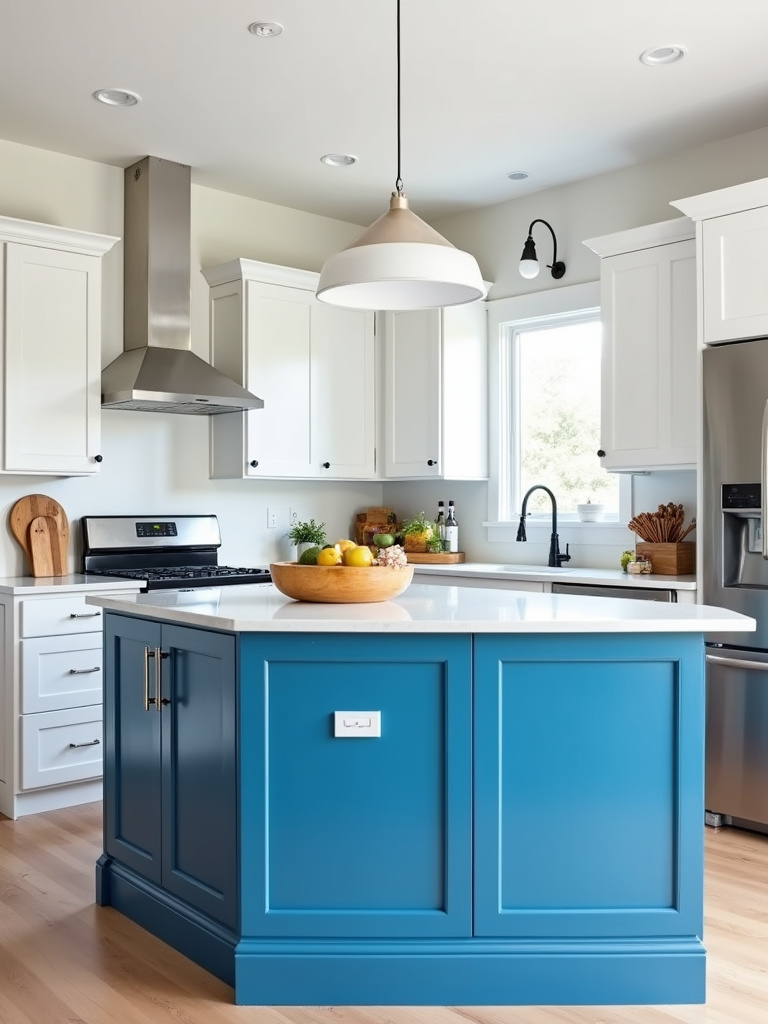
Consider the power of colored accessories – a collection of vibrant cookware displayed on open shelving, bold pendant lights over an island, or a striking piece of artwork can inject personality without permanent commitment. For a more substantial color statement, consider painting your island in a contrasting hue or introducing colorful bar stools. These larger color moments can anchor your space while still allowing the clean, bright aesthetic of your white kitchen to shine.
Remember that color doesn’t have to mean bright or bold. Soft, muted tones can add warmth and interest while maintaining a sophisticated feel. The key is choosing colors that resonate with your personal style and complement the overall design of your home.
There’s something undeniably powerful about a kitchen that fully embraces the purity of white. An all-white kitchen makes a bold design statement through its simplicity, creating a space that feels both serene and sophisticated. The key to successful monochrome white kitchen design lies in understanding how to create interest and depth without relying on color contrast.
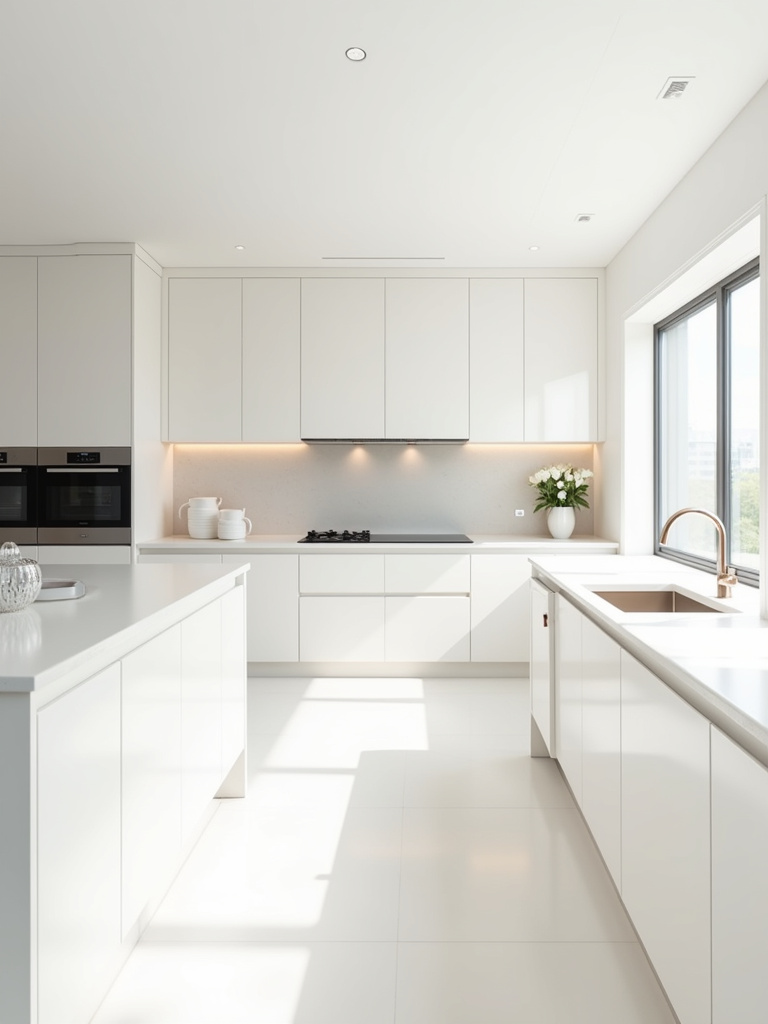
Texture becomes your best friend in a monochrome space. Layer different finishes and materials – perhaps glossy subway tiles against matte cabinet fronts, or a heavily veined marble countertop against smooth white cabinetry. Even subtle variations in white tones can create visual interest while maintaining the clean, monochromatic look. Consider how light plays across different surfaces throughout the day, creating natural shadows and highlights that add dimension to your space.
The beauty of an all-white kitchen lies in its ability to feel both contemporary and timeless simultaneously. It’s a look that can skew modern or traditional depending on your choice of materials and details, offering incredible versatility within its limited palette.
The combination of white and wood in kitchen design is like a perfect marriage – each element enhances the other’s best qualities. Bright white surfaces provide a clean, fresh backdrop that allows the natural beauty of wood to take center stage, while wooden elements add warmth and organic texture to what might otherwise be a stark space. This pairing creates a white kitchen design that feels both sophisticated and wonderfully inviting.
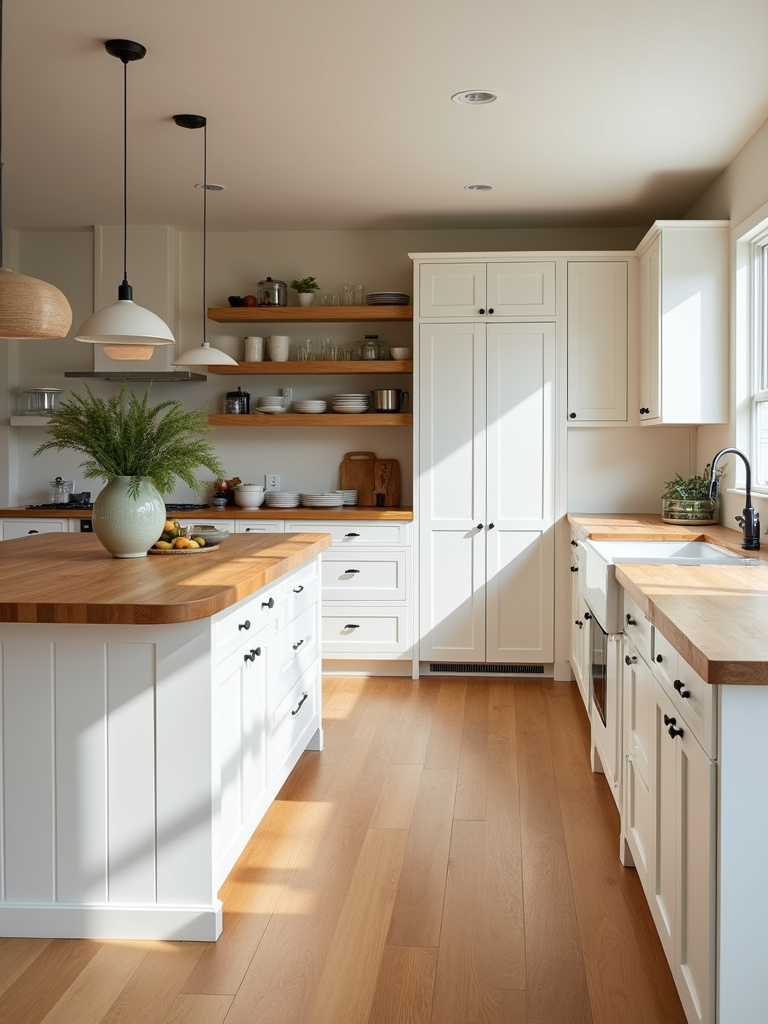
Consider incorporating wood through various elements – perhaps a striking island with a wooden base, open shelving that showcases the natural grain, or a butcher block countertop that adds both warmth and functionality. The key is choosing wood tones that complement your overall color palette. Lighter woods can maintain the bright, airy feel while adding subtle texture, while darker woods create more dramatic contrast.
Don’t forget about smaller wooden elements that can add character and warmth. A collection of wooden cutting boards leaned against a backsplash, wooden utensils displayed in crocks, or a vintage wooden ladder used for tea towel storage can all contribute to the organic, collected feel that makes these kitchens so appealing.
In the world of white kitchen design, islands have evolved from simple workspace additions to stunning focal points that can define the entire room. A well-designed island can serve as both the functional heart of your kitchen and its most striking design element. Whether through contrasting colors, unique materials, or architectural details, your island can become a true conversation piece.
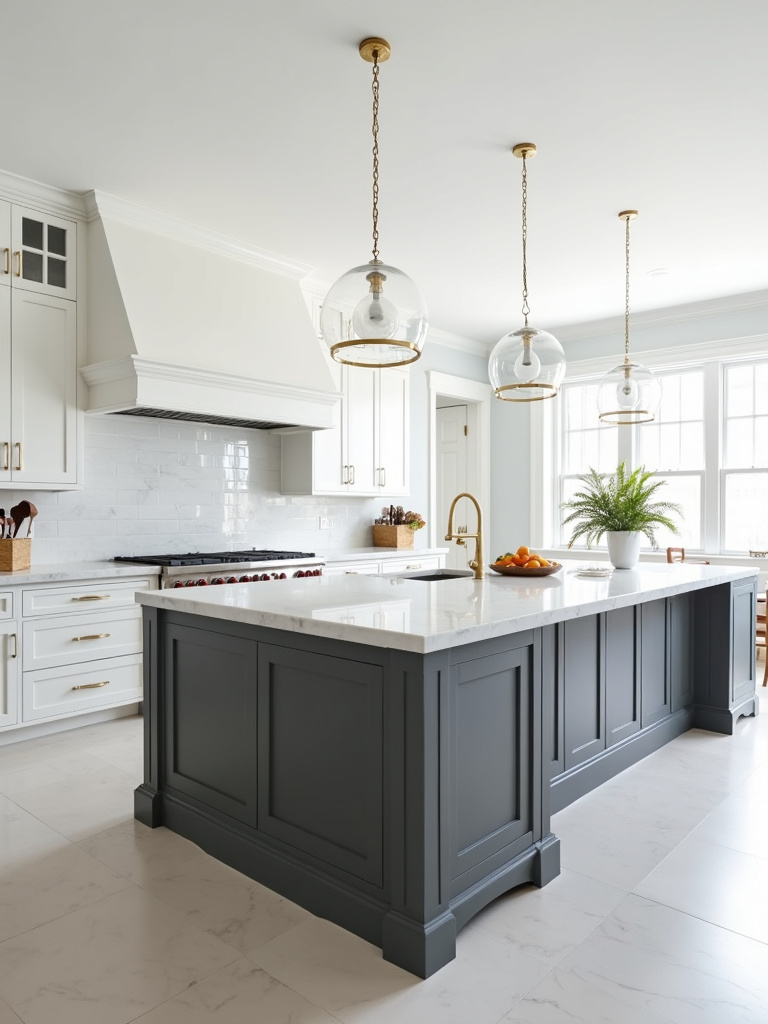
Think beyond the standard rectangular island. Consider unique shapes that complement your space, or architectural details like furniture-style legs or decorative panels. A waterfall countertop in dramatic stone can create a sculptural element, while a bold color choice for the island base can inject personality into an otherwise all-white space.
Remember that your island needs to work as hard as it looks good. Consider incorporating specialized storage, a second sink, or integrated appliances to maximize functionality. The best islands marry form and function seamlessly, creating a piece that’s as practical as it is beautiful.
Creating a beautiful white kitchen design doesn’t require an unlimited budget. With smart planning, strategic material choices, and a bit of creativity, you can achieve a high-end look without the premium price tag. The key lies in understanding where to invest and where you can save without compromising the overall aesthetic.
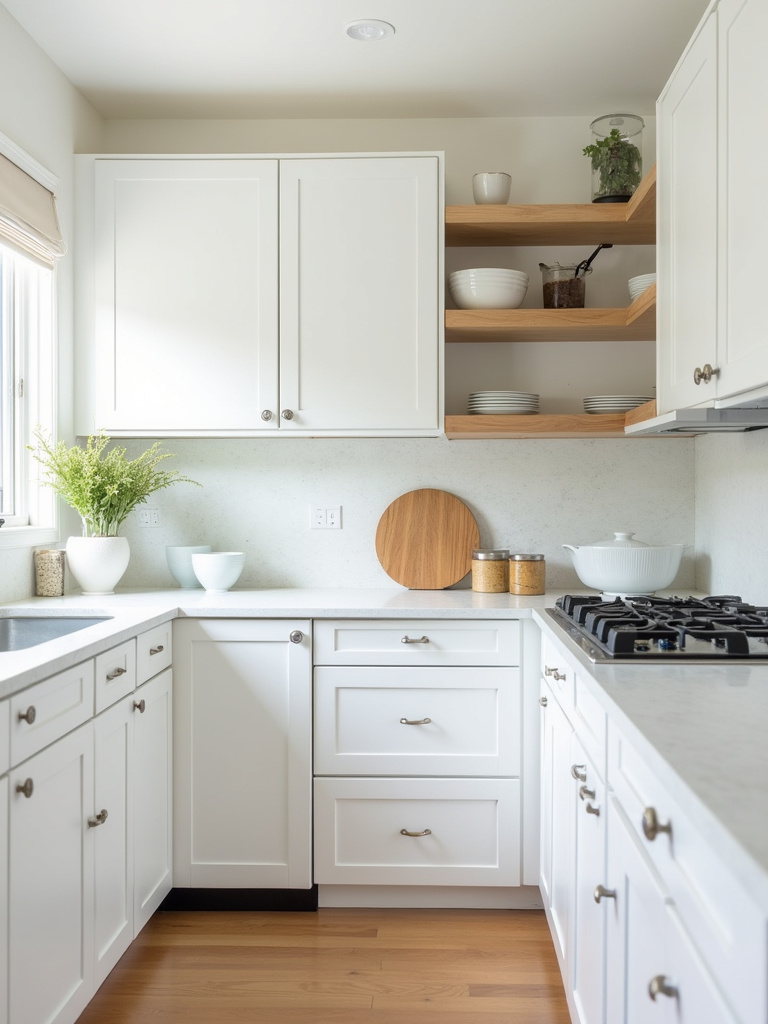
Consider cabinet refacing instead of full replacement – a cost-effective solution that can transform your kitchen’s appearance. A fresh coat of quality white paint, new hardware, and updated hinges can give old cabinets new life at a fraction of the cost of replacement. For countertops, consider alternatives like white quartz or even high-quality laminate that mimics the look of natural stone while offering superior durability and lower maintenance costs.
Smart shopping can also make a significant difference. Look for floor models, end-of-season sales, and remnant pieces for countertops. Even simple changes like updating lighting fixtures or adding a fresh backsplash can have a dramatic impact on your kitchen’s appearance without breaking the bank.
A white kitchen is like a crisp, white shirt – it looks amazing when it’s clean, but requires thoughtful maintenance to keep it looking its best. The good news is that with the right cleaning routine and products, maintaining a bright, fresh-looking white kitchen is entirely manageable. In fact, many homeowners find that the visibility of dirt in a white kitchen actually encourages better cleaning habits, leading to a more hygienic space overall.
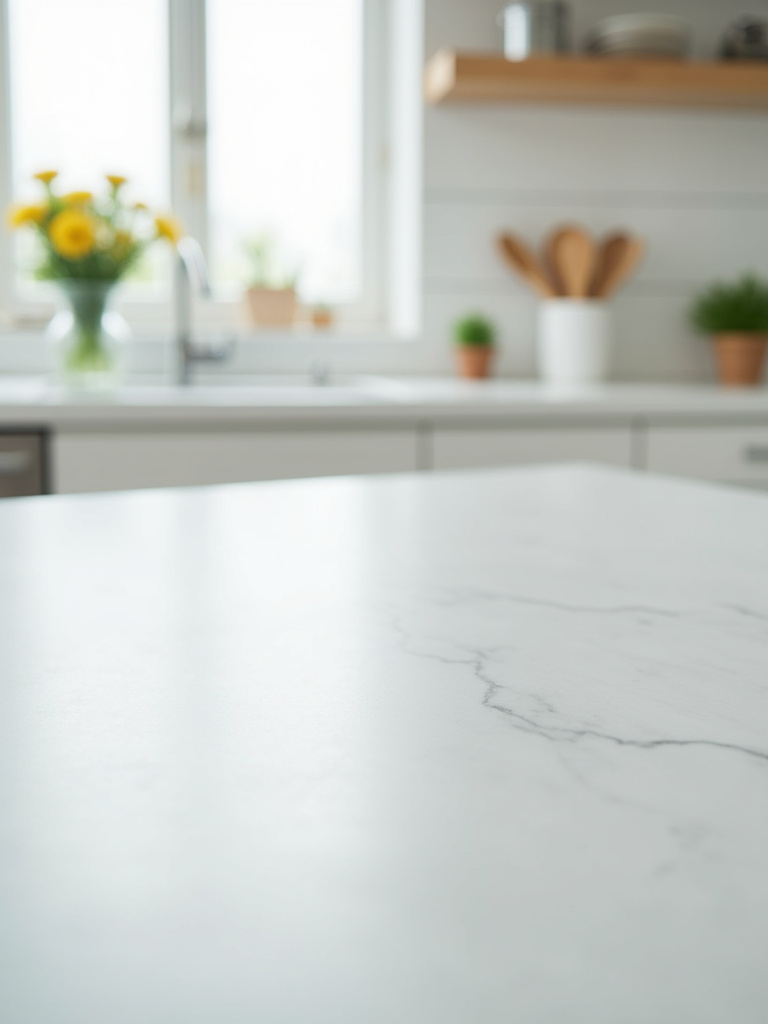
Develop a cleaning strategy that includes daily quick-cleans and weekly deeper cleaning sessions. Address spills and splatters immediately to prevent staining, and use gentle, non-abrasive cleaners that won’t damage white finishes. Consider investing in microfiber cloths, which are excellent at removing dirt and grime without scratching surfaces. For stubborn stains on white cabinets or countertops, a paste of baking soda and water can work wonders without causing damage.
Prevention is just as important as cleaning. Use cutting boards, trivets, and splatter guards to protect white surfaces from stains and damage. Consider applying a sealant to grout lines in tile work to prevent discoloration, and touch up any chips or scratches promptly to maintain that pristine appearance.
While bright white kitchens certainly have their place, there’s something incredibly sophisticated about exploring the subtle world of off-white in kitchen design. Like an artist working with different shades of the same color, using varying tones of white can create depth and interest while maintaining the clean, bright aesthetic that makes white kitchens so appealing.
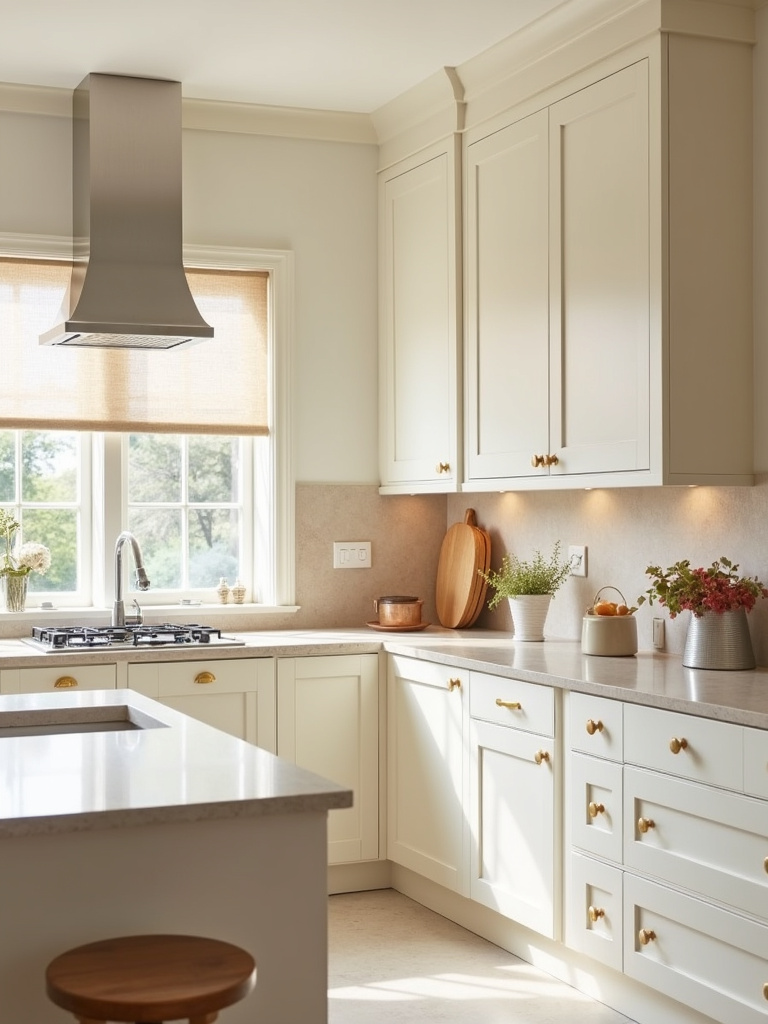
Consider the undertones in different shades of white – some lean warm with hints of yellow or pink, while others have cool blue or gray undertones. These subtle variations can dramatically affect how your kitchen feels. Warm whites tend to create a more welcoming, cozy atmosphere, while cooler whites offer a more modern, crisp appearance. The key is choosing shades that complement each other and work with your home’s natural light.
Remember that different materials will display white tones differently. A white paint color might look different on cabinets than it does on walls, and natural materials like marble or quartz will have their own unique white colorations. Take time to test different combinations in your space, observing how they look throughout the day as lighting changes.
As we’ve explored these 19 dreamy white kitchen design ideas, it’s clear that the enduring appeal of white kitchens lies in their remarkable versatility and timeless beauty. Whether you’re drawn to the crisp minimalism of modern design, the warm welcome of farmhouse style, or the sophisticated elegance of classic white kitchen design, there’s a perfect interpretation waiting to be discovered for your home.
Remember that creating your dream white kitchen is a journey of personal expression. While following design principles and trends can provide valuable guidance, the most successful white kitchens are those that reflect their owners’ unique style and practical needs. Whether you’re working with a generous budget or making strategic improvements over time, the key is to create a space that not only looks beautiful but functions perfectly for your lifestyle.
As you embark on your own white kitchen design adventure, let these ideas serve as inspiration rather than strict rules. Mix and match elements that speak to you, experiment with different textures and materials, and don’t be afraid to inject your own personality into the space. After all, the best white kitchens are those that feel both timeless and personally meaningful – spaces that welcome family and friends while standing the test of time both functionally and aesthetically.
Your perfect white kitchen awaits – one that combines the pristine beauty of white with your unique vision to create a space that’s truly your own. Whether you’re planning a complete renovation or a simple refresh, the versatility and enduring appeal of white kitchen design ensures that your investment will bring joy and functionality to your home for years to come. Pendant lights hang above the island. Camera at eye-level, full scene, no people, bright natural light.